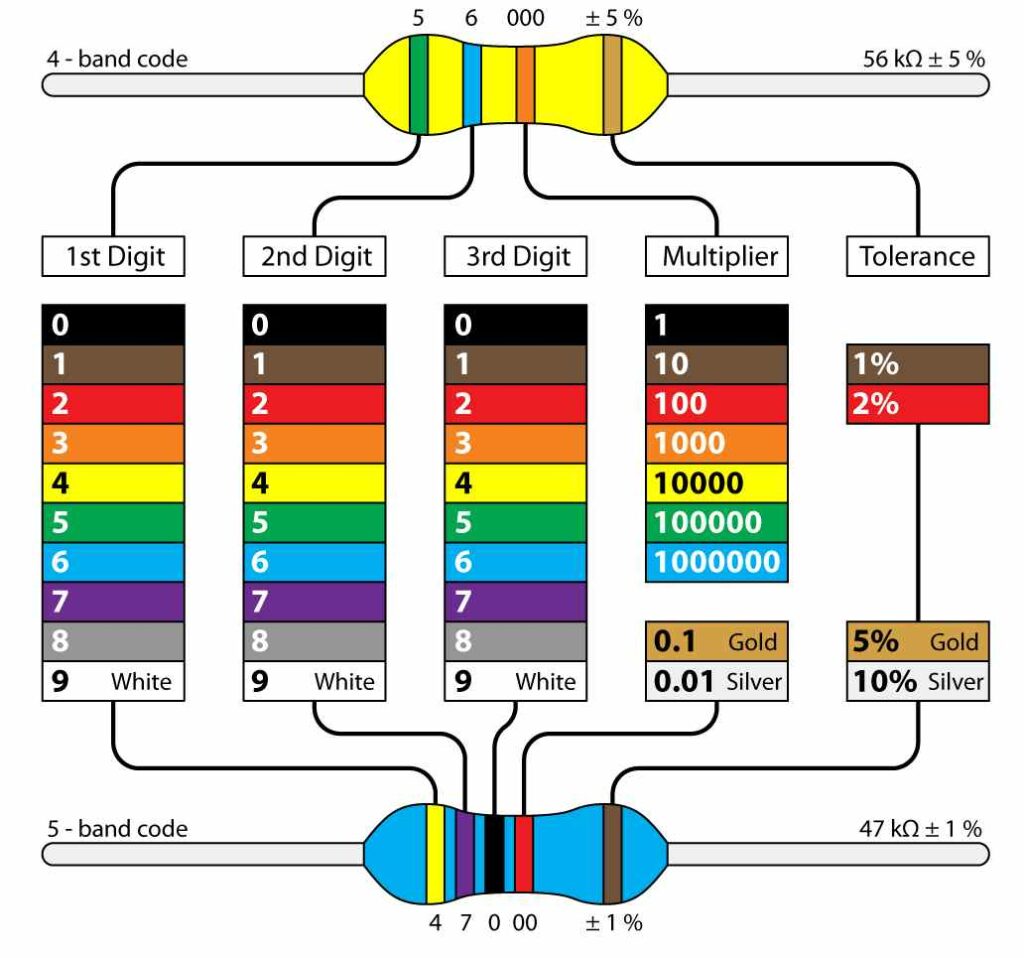A 2.2K resistor refers to a resistor with a resistance of 2.2 kilo ohms, or 2200 ohms. Resistors are fundamental passive components used in all kinds of electronic circuits for limiting current flow, adjusting signals, dividing voltages and configuring functionality blocks.
This article provides an overview of the 2.2K ohm resistor value specifically – its properties, color coding, availability, pricing and some example use cases across common applications.
Contents:
- Resistor Fundamentals
- Significance of the 2.2K Value
- Color Band Coding
- 2.2K Resistor Availability
- Pricing Trends
- Application Examples
- Equivalent Circuits
- Conclusion
Resistor Fundamentals

A resistor is a two-terminal electrical component that provides a defined amount of resistance (opposition to current flow) within a circuit. By controlling amplitude and directing electron flow, resistors enable building various analog or digital logic blocks.
Key properties include:
Resistance – Measured in ohms (Ω)
Power Rating – Maximum (volt-ampere) rating before overheating damage
Tolerance – Acceptable +/- deviation from nominal resistance
Temperature Coefficient – Change in resistance based on temperature rise
Resistors are available in a wide range of resistance values from <1 ohm to >1 giga-ohm as per application requirements. We next examine the relevance of the 2.2 kiloohm value specifically.
Significance of the 2.2K Resistor Value
The 2.2K ohm is a standard resistor value within the preferred numbers series across resistors. It provides a mid-range resistance suitable for general voltage divider configurations, pull up/pull down networks and termination loads.
Some usefulness criteria for 2.2K resistors:
Mid-Range Value – Suitable for typical voltage biasing needs between 1K and 10K range.
1% Tolerance Available – Precision functionality for analog crossovers, timing circuity etc.
Quarter Watt Power Rating – Adequate power handling for most low frequency boards.
Cost-Effective – High volume availability across suppliers ensures competitive pricing.
In the next section, we look at the color coding used to identify 2.2K resistors.
Color Band Coding for 2.2K Resistors
The ubiquitous 10-100 ohm resistors use color bands for quick value identification through visual inspection. The 4 band sequence denotes:
Band 1 – Left Digit (First two significant figures)
Band 2 – Right Digit (Third significant figure)
Band 3 – Multiplier
Band 4 – Tolerance
For 2.2K ohm, standard color bands would be:
- Red – (2) for left digit
- Red – (2) for right digit
- Red – (100x multiplier)
- Gold – (+/- 5% tolerance)
Some variants may use an additional band for temperature coefficient specs.
2.2K Resistor Availability
Owing to wide applicability, 2.2 kilo ohm resistors are instantly available off the shelf from all major manufacturers and distributors in leaded, surface mount and through-hole package styles.
Common options include:
Through Hole – Axial, Carbon Film, Metal Film, Wire Wound
Surface Mount – Thick Film, Metal Film, Metal Oxide Film, Carbon Composition
Size – 0402, 0603, 0805 and 1206 SMD sizes stocked
Power – 1/8W, 1/4W and 1/2W variants inventoried
Tolerance – 1%, 2%, 5% and 10% tolerance options readily available
We next look at price trends.
Pricing Trends
As per latest distributor data, 2.2K ohm resistors cost between $0.03 to $0.05 unit price based on:
Package – Smaller 0402 size is cheaper than 1206 variant
Tolerance – 1% tolerance fetches premium over 5% or 10%
Power Rating – 1/4 watt units cheaper than 1 watt types
Brand – Established makers like Vishay cost more
Quantity – Bulk order discounts apply on 10,000+ units
We now discuss application examples leveraging 2.2K resistors across common circuits.
Application Examples
Voltage Divider – Fixed ratio signal attenuation from higher to lower voltages.
Pull-up/Pull-down – Biasing digital signals closer to positive or negative rails.
Timing Circuits – Establishing RC time constants across clock generators, differentiators.
LED Current Limiting – Current control for luminosity control.
Logic Gate Biasing – Providing gate threshold stability.
Termination – AC termination loads using series resistor to match trace impedances.
Voltage Reference – Reference voltage bias points for op-amps.
We finally suggest some alternate resistance values providing similar functionality.
Equivalent Resistance Values

Owing to variance in real-world resistors and effects of temperature, the following E24 values can serve as potential replacements fitting nearby 2.2K ohm applications:
- 2.0 K ohm
- 2.2 K ohm
- 2.4 K ohm
Using higher wattage rated resistors also serves equivalently in most scenarios.
Conclusion
In summary, the 2.2 kilo ohm resistor offers a versatile mid-range resistance making it useful for basic analog biasing, timing applications, pull up/down networks and termination loads across common electronic systems and PCB products where precision is not paramount.
I hope this piece provides helpful perspective on the standard 2.2K ohm resistor widely adopted across consumer and industrial electronics. Please do share feedback or queries by commenting!
